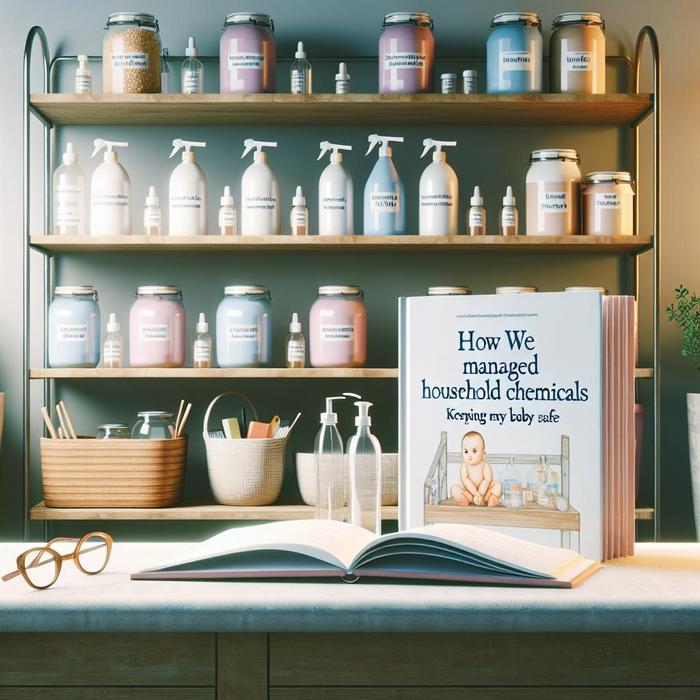A New Parent’s Guide to Preventing Poisoning
As new parents, we were overwhelmed by all the tasks we needed to manage in order to keep our baby safe. Babies, with their natural curiosity and instinct to put everything in their mouths, require constant vigilance. One of our most significant concerns was how to secure household chemicals safely. In this post, we will share home safety tips and our journey to achieving safe chemical storage and using non-toxic alternatives at our home.
The Hidden Dangers at Home
First of all, we realized that potential dangers lurk around every corner of our home, most notably, within our cleaning supplies. Commonly used products like detergents, all-purpose cleaners, and insecticides contain hazardous chemicals that can be extremely harmful, if not fatal, when swallowed or inhaled by infants. Fortunately, there are numerous measures available to protect our curious little ones from these hazards.
Safe Chemical Storage
Here are some of the steps we took to ensure safe chemical storage:
- We always keep chemicals in their original containers. It’s easier to keep track of what’s what and most of these containers are child-resistant.
- Childproof locks were installed for cabinets where we store cleaning products and other chemicals.
- We never store hazardous materials in containers used for food or drink as it can cause confusion.
- Products were always stored out of sight and reach of our baby.
For more detailed guidelines on safe storage of household chemicals, check out this resource from Health Canada.
Non-Toxic Alternatives
Another critical step in preventing poisoning was turning to non-toxic alternatives wherever possible. This not only reduced the risk of poisoning but also ensured a healthier environment for our baby to grow up in.
We replaced synthetic air fresheners with essential oils, and instead of harsh cleaning chemicals, we started using natural ingredients like vinegar, baking soda, and lemon juice. Not only did this reduce the potential risk of poisoning, but it also made our home a healthier place to live in due to reduced indoor air pollution.
For more tips on how to babyproof your home, check out this useful article from Parents.com.
Stay Vigilant, Stay Safe
Keeping your home safe for your baby may seem like a daunting task, but by implementing these preventive measures and being vigilant, you can create a secure environment for your child to explore. Household safety isn’t just about locks and gates; it’s also about being educated, prepared and always on the watch.
Remember, preventing poisoning starts with you. For more tips and advice on raising a safe and happy child, visit our earlier blog post on enhancing your baby’s development.
Understanding the Hazardous Chemicals in The Household
Took the time to understand the potentially toxic chemicals that we commonly use at home was a significant step in our journey. According to BetterHeatlh, a considerable number of common household products could potentially be harmful. These range from cleaning supplies to personal hygiene items and even some types of house plants.
Emergency Preparedness
Knowing what to do during chemical emergencies in our household became a priority for us. We learned the importance of having emergency contacts readily available, including the poison control center and our family doctor. Additionally, we created a game plan on what steps to take in case a poisoning incident did occur.
You can find more details about emergency preparedness during household chemical emergencies at Ready.gov.
Proper Disposal of Hazardous Materials
Ensuring we disposed of any chemical waste correctly was another step we took seriously. We learned some household hazardous waste could contaminate our water supply if not properly disposed of. Following guidelines for disposing of various types of waste – from batteries to paints and cleaning products – was crucial.
For more information, consider visiting this useful article from the Environmental Protection Agency (EPA).
Educating Ourselves and Others
Education emerged as one of the most valuable tools in our path to prevent child poisoning. By better understanding the potential hazards, we could make safer choices. Besides, we made it a point to educate our friends and family visiting us about our chemical safety measures to ensure our baby’s safety at all times.
Trust and Verify
Believing the label or marketing claims blindly was something we decided to avoid. Instead, we researched every product before purchase, from cleaning supplies to toys, verifying their safety for our baby.
Staying Up To Date
New products, safety standards, and guidelines are constantly being introduced. Hence, staying updated with the latest safety-related news was another measure we decided to imbibe for the safety of our baby.
Your Role in Your Baby’s Safety
Being a new parent is overwhelming, but the safety of our baby is paramount. With careful planning and vigilance, any home can be made baby-safe.
Please remember that we all play a crucial role in preventing dangers like poisoning. Follow these tips, share your insights and experiences, and help us create a safer world for our little ones.
